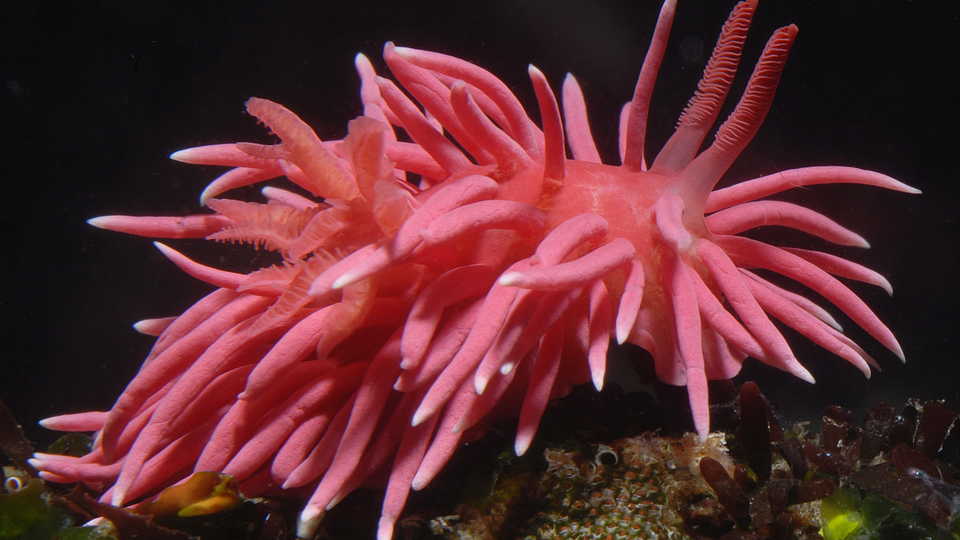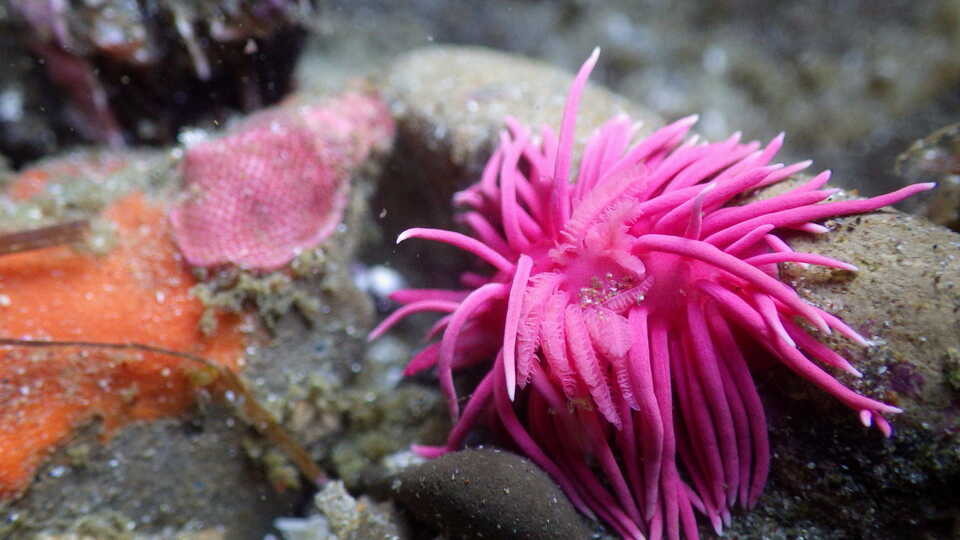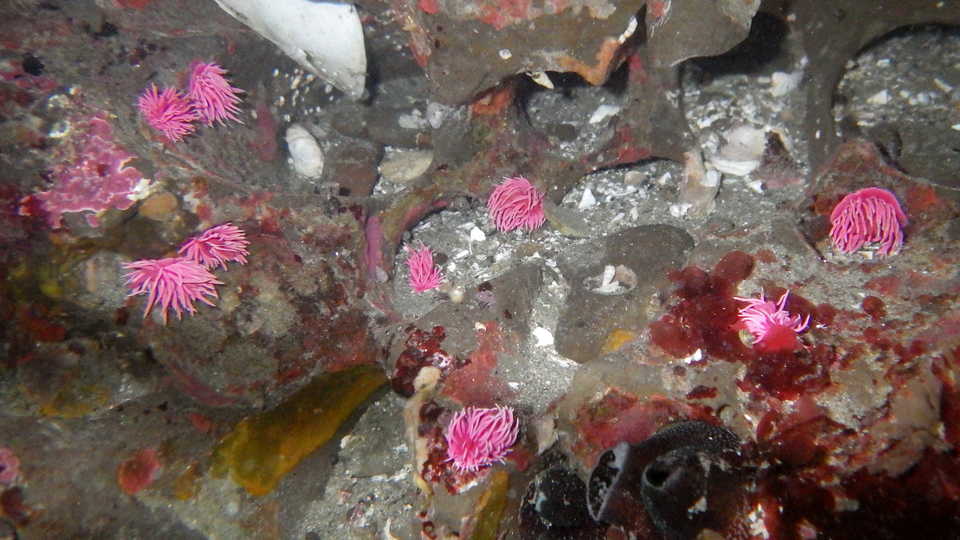A bloom of vibrant pink nudibranchs along California’s coast may signal a serious shift in ocean climate
SAN FRANCISCO (January 29, 2015) – The warm ocean temperatures that brought an endangered green sea turtle to San Francisco in September have triggered a population explosion of bright pink, inch-long sea slugs in tide pools along California’s central and northern coastline. The Hopkins’ Rose nudibranch, while no strange sight in Southern California, is rarely spotted farther north. A team of scientists, including experts from the California Academy of Sciences, believes this far-flung Okenia rosacea bloom—along with a slew of other marine species spotted north of their typical ranges—may signal a much larger shift in ocean climate and a strong forthcoming El Niño.
Researchers from the California Academy of Sciences, UCSB, UCSC, and Bodega Marine Laboratory as well as dedicated citizen scientists from across the state are carefully tracking the atypical sea slug distribution, reporting densities in the dozens per square meter in tide pools from San Luis Obispo to Humboldt Counties. The pink nudibranchs have not appeared so far north or in such high numbers since the strong El Niño events—periods of warmer-than-usual ocean water and heavy rains—of 1998 and 1983.
Groups of volunteers were among the first to document and raise flags about the surprising nudibranch population explosion last fall, tracking their nature observations on iNaturalist, a citizen science platform available on mobile phones. Citizen scientists, including participants in the Academy’s intertidal monitoring program, snapped photos of Okenia rosacea outside their typical range, which were logged with date, time and geographical data on iNaturalist’s global interactive map. These observations are publicly available, are shared with the leading global biodiveristy database (Global Biodiversity Informaion Facility, known as GBIF), and add to our understanding of biodiversity—and its complex shifts—for scientists and non-scientists alike.
Without an official El Niño on record for 2015, scientists note that the recent sea slug bloom may mirror a much larger climate shift that occurred in the eastern Pacific Ocean nearly four decades ago. In 1977, rose-like Okenia rosacea appeared in record numbers along the California coast under weak El Niño conditions, coinciding with a major, decades-long period of elavated ocean temperatures. Warmer coastal waters altered the ranges of many ocean-dwellers, including several species of gastropods, fishes, and dolphins.
“While we are thrilled to see this beautiful bloom of normally-rare nudibranchs, we are concerned about the long term consequences of our changing coastal environment,” says Dr. Terry Gosliner, Academy Curator of Invertebrate Zoology and Geology. “Our current climate conditions are great for some of my favorite slugs, but we can’t ignore that warming seas mean less food for sea birds, and adverse impacts for all marine ecosystems. California’s unique marine life can’t always adapt to so much instability.” Gosliner adds that frequent habitat disruptions could point to mass extinctions in coming decades.
In a 2011 report in Limnology and Oceanography, Gosliner and a team of marine experts linked widespread nudibranch blooms with periods of warming ocean temperatures. The report predicts a range-shift in sea slug populations when warm temperatures, northward ocean currents, and weak upwelling (a phenomenon that pushes cold, nutrient-rich water to the ocean’s surface) overlap. “We’re seeing this exact cocktail of climate conditions in California right now,” says Gosliner. “We are tracking the trends to find out exactly what the shift means and how it might impact marine life.”
Hopkin’s Rose nudibranchs are ideal for tracking relatively rapid changes in ocean conditions. The showstopping slugs are fast-growing, live for about one year, and tend to spend their adult lives in a small patch of the ocean floor. Like previous population explosions of Okenia rosacea, the current nudibranch bloom includes species typically found farther south, including the bright purple and orange Spanish Shawl, Flabellina iodinea, and the California Sea Hare, Aplysia californica.
Though researchers believe the recent nudibranch population explosion might signal another major climate shift from cold to warm, it is simply too early to call. If a major ocean climate shift is in fact underway, Academy Research Associate Dr. Jeff Goddard believes there is a good chance the next El Niño will pack a punch on par with the 1983 and 1998 California events. As with any strong El Niño event, Californians should expect to see many species from Southern California appear farther north.
It doesn’t take a scientist to spot a bright pink Hopkins’ Rose nudibranch or help with statewide tracking efforts in local tide pools. Californians can snag a prime view of the current sea slug bloom in rocky shore tide pools along the Central Coast at Montaña de Oro and Asilomar State Parks, Scott Creek Beach, Pigeon and Pillar Points, and Fitzgerald Marine Reserve just north of Half Moon Bay. North Coast slug-finders can visit Duxbury Reef at Bolinas in Marin County. Check your local tide predictions, and aim for a “minus tide” when both the swell and wind are low. Tread lightly when exploring tide pools, be sure to wear shoes you won’t mind getting wet, and help scientists track the bloom with the iNaturalist app on your mobile phone.
The Institute for Biodiversity Science and Sustainability at the California Academy of Sciences is at the forefront of efforts to understand two of the most important topics of our time: the nature and future of life on Earth. Based in San Francisco, the institute is home to more than 60 research scientists and aquarium biologists, as well as 45.6 million scientific specimens from around the world—nearly 40,000 of which are alive and on display in the Academy's Steinhart Aquarium. The institute also leverages the expertise and efforts of more than 100 international Research and Field Associates and 300 distinguished Fellows. Through expeditions around the globe, captive breeding programs, and investigations in the lab, the institute's scientists strive to understand the evolution and interconnectedness of life. Through these same efforts, as well as through partnerships, community outreach, and public engagement initiatives, the institute aims to guide critical conservation decisions and address the challenge of sustainability. Visit www.calacademy.org for more information.
Press Contacts
If you are a journalist and would like to receive Academy press releases please contact press@calacademy.org.
Digital Assets
Hi-res and low-res image downloads are available for editorial use. Contact us at press@calacademy.org to request access.


